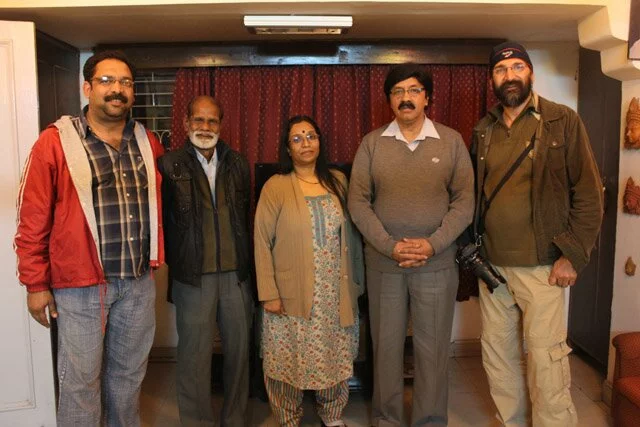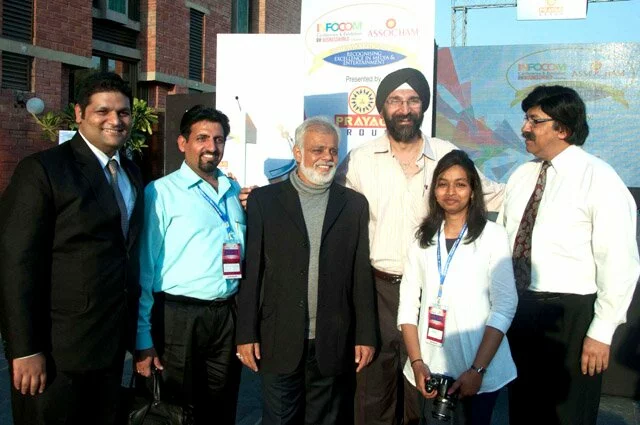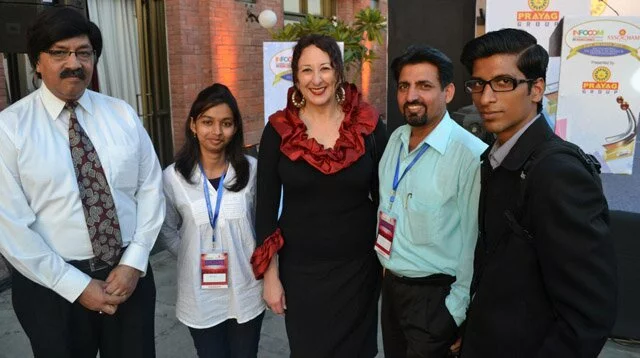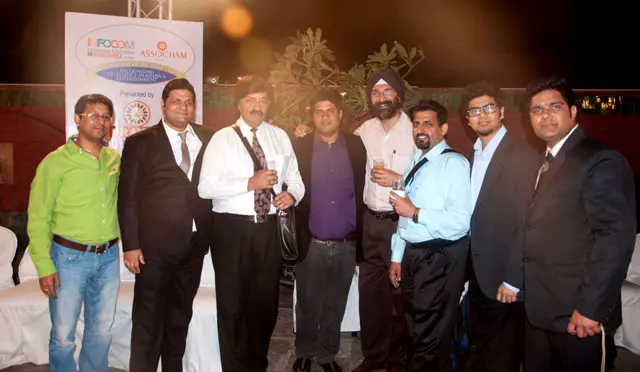Madan, last when we spoke to you, your passion for animation was more than evident. In the months that have gone by, in fact a full year, we hear about your "Roshni" remake, Jai Mata Di - Pehla Bulawa, and a host of ideas on home-grown productions. You are also providing lots of interactive multimedia services to various organizations, guest lecturing, and now your foray into forensic analysis of audio and video materials. Your announcement of Retro Zamana,and now "Sawan ka Mahina" on the flute ... you simply have all that talent to BE there. It is set to create ripples in the animation world. Let me start by asking you about your music, and how you acquired that interest.
What is "Retro Zamana"? How did it cross your mind, when you are more into animation? Please tell us about it in detail.
Good starting point for today. If you recollect the last time we spoke, I had said I was born a musician, but couldn't ever get the opportunity to learn. It just came as a god-given gift. After doing my Higher Secondary in 1972, I was free for almost 4 months till college started. I bought a small flute from the gali-gubbara-vala for 25 paise, and started blowing it out for Jana-Gana-Mana, our National Anthem. It played out well and I took to the flute, playing other songs as well. It then struck me that if I could play one instrument, why not others, and I taught myself the Hawaiian guitar also. Professional performances followed. I performed on Yuva Vaani, Aakashvani and Doordarshan as well, teaching myself every instrument I could lay my hands on. The talent almost fizzled out with my tedious schedules in service. When I started my early second innings in life - pursuing my passion for art - all the music came rushing back - the songs of the 50s, 60s and 70s and some that I myself had created. That's when I set up the sound-proof walls in my studio, to sing to myself, and test it out. My first vocal recording, Raat Kali ek Khwab mein aayee, produced very encouraging responses - not just my ability to sing and play instruments alongside, but also the quality of recording that I could produce. Then came back the flute - Saawan ka Mahina - a 60s hit - accompanied by 108 requests for the full track. And RETRO ZAMANA was born - a collection of all my old songs, all re-done by me. First album is vocal, second is the flute, third is the Hawaiian Guitar and Fourth is duets on flute/Mouth Organ, and Hawaiian Guitar. Strangely, the Hawaiian Guitar is almost a dying species. And if my RETRO ZAMANA can do something for this beautiful melodious instrument, I would love to keep it alive.
First "Yuva Vani" then "Aakashvani" followed by Civil Services and now Animation. Your journey so far is pretty varied. What drives you to such vivid achievements?
Frankly, I don't know. Music came naturally, and I wish I could learn it, the raagas, the gharanas, and the professional performances. I often used to hear an Aakashvani programme every morning, I think it was called 'Saaz aur Awaaz' which played a film song, and then discussed its Raaga, and the theory and timing of the Raaga. I think I picked up Raaga Yaman Kalyan, Raag Des and Raag Malkauns only on that programme. I also felt quite jealous of some friends who performed really well - Rajendra Kachroo, Jawahar Wattal, Alok Sahdev, Amarjeet Sahni, Manisha Bandhu, Renu Kaul, Abaradita Moitra, Madhura Dixit - established names in the music industry today. I'm still jealous of them, but much more nostalgic now. Then one day I suddenly sketched my two young daughters and Raveena Tandon and Hema Malini, of whom I am a fan. Really good ones they came out to be. That also gave me the inspiration to try drawing and sketching for art. When computers first came into Government, around the mid 1990s, I was determined to make them do what I wanted them to do, not let them do what they are capable of doing. That was the time I made my first animation on a software package called Harvard Graphics - an almost impossible task. I played live music myself with that animation. It was Hema Malini winking an eye, as in Sholay, raising her hand and bending her neck, in a Bharat Natyam dance motion. There were no scanners, and computers did not have audio capabilities. So I had to draw with the mouse (the trackball variety), and play the music live. There were also no training institutions then. The day I thought I had done something excellent, I had tears of joy in my eyes, and I gave myself this profession - the passion of art in all its forms, and making it come alive in my second innings in life.

Music or Animation? Which of these attracts you more and why?
The choice is very difficult and inseparable. Both complement and supplement each other. Whenever I feel exhausted in one, I take to the other. Together, both revamp my energies and keep me going. More than that, together they also make me a one-man army to do my creative work, swing back my moods and fire my imagination to the sky. I would be lying if I picked one over the other. Honestly, I am not able to answer that one.
"Learning is a never ending process"! What do you learn in your free time?
Dead right. I learnt very early in life that the process of learning never ends. Therefore, I find it the most punishing aspect of life to sit quietly. So when computers first came in to Government offices, and there was no place to learn them, I used all my free time to master them as much as possible, reading their manuals, exploring them, experimenting with them, doing all sorts of creative tasks on them. When I bought my first PC, an XT machine, and it broke down, I literally cried (they were so expensive). I taught myself how to assemble them, repair them, and put them back to work, using my free time for that purpose. Later I taught myself graphic design, animation and mixing the arts for fabulous results. Then came very specialized software applications as computing power increased in direct proportion to affordability and ability. Sound, video, moving images, motion graphics, all became possible sitting at home. Today I try to learn almost everything that animation requires - software applications, presentation skills, music, vocabulary for script writing, video editing, VFX, sound design - everything. The process of learning never ends.

What is your next step in Animation Industry?
My mission is PRODUCTION. By production I mean IPR, creative excellence. If there is production there is investment, income and jobs. Most of the work we do today is outsourced contracts for others - as service providers, not as producers. A nation-wide industry cannot build itself merely in search of contracts in the market. It has to create its own market, nourish it and drive buyers to it. I find lots of animators enter by passion and exit by depression. It doesn't seem to be anyone's fault, and I'm not trying to find fault also. But there are too many gaps, and I want to find these, and help fill these, since animation is not making much business sense. Hardware is costliest, software is costliest, labour is costliest (and most intensive), marketing is even costlier than making the animation itself, and yet it is not the animator who is laughing his way into the bank. Every other sphere of IT has become affordable, not animation. Every other sphere of IT has buyers, not animation. Perhaps every other industry has Government support, not animation. The next step is to make all of us animators THINK industry, TALK industry and WALK industry, and I intend walking the talk. Lots of areas need to be addressed - Hardware, software, market concerns, Government support, learning processes, the stakes of various stakeholders and their respective linkages. Training needs to talk to production; production skills have to percolate, Studios need to talk to each other and the market, market surveys and research need to be done, an information system, standards and certification for the industry need to develop, the market needs to talk to Government, banks, financiers, etc. Today, any animator who wishes to finance his or her production does it out-of-pocket. The risks associated with large-scale financing are beyond the reach of most animation production houses and studios. If production is large-scale, economies of scale will also apply automatically. I am also aware most animation studios and freelancers don't come out in the open because of software issues - 'victims' of software piracy. I do not support piracy at all. But I want the buyer as well as the seller to know that there are alternatives available and 'talkable' to overcome their fears. On 'intensive labour', production houses are worried that once their employees learn the 'tricks of the trade' they disappear, right in the middle of the projects. I want to help production houses overcome that fear also. Students fear low salaries and extended work hours. If salaries are paid as per expectation, costs of production soar sky-high. If salaries are not according to expectations, promises of training institutions turn up side down, and their viability gets affected directly, which is what is happening now. "Unpaid Animators" is yet another area of major concern. So everything does boil down to Production actually taking place and being paid for. Success stories are there to eulogize, but we still cannot hold our own ANIMATION FILM FESTIVAL for want of productions. The reality at the grassroots is too stark. To bring out the mutual interdependence in the industry and to bridge its gaps is my next step, if I may say so.

We have got very talented and skilled animators in India but why can't we make Animation movies like Dreamworks and Sony Pixar. What is lacking in our Industry?
Good question. As I said earlier, there are too many gaps in our Industry. Production is not really making business sense because of these gaps. We are neither IT, nor film making. Production is a costly affair, marketing is even costlier. Now if your production, god forbid, does not do well at the box office, you easily become a 100% depreciated system even before you can think of your next venture. The risks are too high and incalculable, with no institutional arrangements to help you out. There is no financier, no insurance cover, no health cover... nothing. Animation is all open to extreme risks of the market. Tell me, how many people are willing to pay to watch Indian Animation? We don't even have our own Indian Animation TV Channel or market. But it's not all that creepy also, and there is hope. There are animators who are doing very well. We've had brilliantly made Indian Animation films doing well in the international market also, reaching for the Oscars. We need more like that, and we need to make that possible. The fact that alternatives and ideas are also being thought of, and available, makes it possible to knit the industry together into a world-class animation production hub. And there are organizations working towards that goal.
From the past 1 year, what evolution have you observed in the Global and Indian Animation industry?
Generally, it hasn't been a good year for any industry, with economies struggling to come back on track. Animation is no exception. We saw Rhythm and Hues reach the Oscar, and yet close down. Disney closed two of its studios PERMANENTLY. Back home studios and training institutions closed down. Yet the films that released in that one year did pretty well. The top 10 grossed more than US $ 3861 million.
See this chart...
 source - wikipedia
source - wikipedia
Back home Chhota Bheem and the Curse of Damyaan; Arjun - the Warrior Prince; Delhi Safari were runaway successes that catapulted Indian Animation to International center stage. Animation festivals and competitions are also more and dense, internationally. I would say the world is maturing to animation beyond cartoons for kids, and I can foresee Indian Animation following suit - shedding mythology for a different approach to animatable subjects and stories. Globally, animators are willing to produce better and better animation, with VFX and Gaming taking the leads. In India also the trend is visible, with a much larger focus on quality. But home-grown production of world class calibre is still to make its presence felt globally.
In recent times, there has been a rush for jobs in the Animation Industry. Why can't we give jobs according to their will?
Whose will? When we look at animation from the job angle, we are looking at those who can use the tools, and are fully dependent on the story board or the Art Director to actually perform. Very little of creativity and IPR actually happens on one job, even if it is an animator's dream to some day make a Pixar or a Disney. The other reasons are simple, and I stated most of it earlier. Our Animation Industry is not so well-organized or oiled. It is still not able to attract significant investment or viewership. Sometimes small is beautiful, sometimes big is economical. Because production is a costly and very risky affair and small in number, and outsourced contracts don't come in all the time, the dynamics of the industry keep changing, as does the technology backing it. A well planned and executed production pipeline often faces the problem of adjusting to the dynamics of its own requirements. Finally, it will be the market and production dynamics that will decide what kind of jobs will be available and put out. For example, over the last three years we had this huge debate on whether animation in 3D was better than 2D, and which one was going to stay. Almost every newcomer took to Maya and 3D, mainly modeling and character animation. In the last six months, however, I have experienced a much larger demand for 2D, Flash and Anime. That makes the Mayas redundant for the time being.
What would you suggest to those who wish to do freelancing instead of Job?
I think it is very difficult to differentiate between the two. Freelancers are entirely dependent on outside contracts, but learn almost all tricks of the trade. In jobs, an animator specializes only in one small segment of the production pipeline. He doesn't remain an animator, unless he freelances in his 'available' time. He becomes a modeler, texture artist, lighting artist or some other 'segment'. Freelancers would do well by associating with production houses and studios as a regular measure, and do their own production in their 'spare' time. And yes, the learning process should never end. Both have to continuously evolve on how to tell stories in better and better ways.
What are your expectations from " Gurumantra" this year?
Well frankly, I am quite disappointed at the responses to SAID's Flagship event GURUMANTRA. Gurumantra as you know is neither a master class, nor a training session. It is very simply and clearly an attempt to bring home-grown, local experts in animation, face to face with learners. And since the process of learning never ends, EVERYONE can be a learner ALL the time. So when we hold GURUMANTRAs for the sake of bringing the industry together, bringing learners and experts face to face, bringing the "inside" knowledge out, and that too tirelessly, without any eye on individual gains or scores, it leaves a very bad taste in the mouth, when the industry experts find learners disinterested. We are literally forced to keep the learners' seats limited to 60 only in every GURUMANTRA. We introduced MoMs (Moments of Mementoes) to confer on outstanding contributions to the Indian Animation Industry, to generate interest among creators, bring about more IPR. But I am sorry to say, a very large majority of animators in and around Delhi are deeply asleep, too skeptical and disinterested in the industry as an industry. This year, as more and more professionals are taking up LIFE MEMBERSHIP of SAID, we hope that GURUMANTRA will be able to generate more interest among the learner-animators to pick up the skills and industry developments as they interact with professionals and experts. We also expect to felicitate more and more animators in and around Delhi with MoMs, at these GURUMANTRAs.

You are always with Animation Industry and still seen vehemently with it. How do you have such passion?
Well, generally, the arts attract me no end. Particularly as all of them, be it music, drawing-painting, clay modeling, sculpting, whatever... are able to overcome all barriers of language, caste, religion and other divisions of society. Animation, where sky is the limit to one's imagination, has that boundless potential to bridge the distance between minds - artistically. I find it a language of the mind ... to boldly go where no man has gone before. It brings almost ALL the arts together. I just love animation, and the ones who really work with it - creative and artistic. My meeting with Nish Takia, the maker of Delhi Safari, the creative Pops, Susan Erokan of Dreamworks, and other animators at the METS FORUM 2013 in Delhi, was simply a demonstration of that love. These people had absolutely no hesitation to smile, hold hands, rub shoulders, sing, drink and dance with us. Oh! That's what I call real birds of feather...
"Animation with a cause"- How important is this for you?
To me that's going to be the future of Animation, the next generation. When you add a purpose, a cause to your artistic passion, it becomes much more meaningful and pursuable. Join hands with a cause and see your creative abilities in an entirely new light, take wings, and put you on a flight to soaring heights.
Interview by Mukesh Dube

